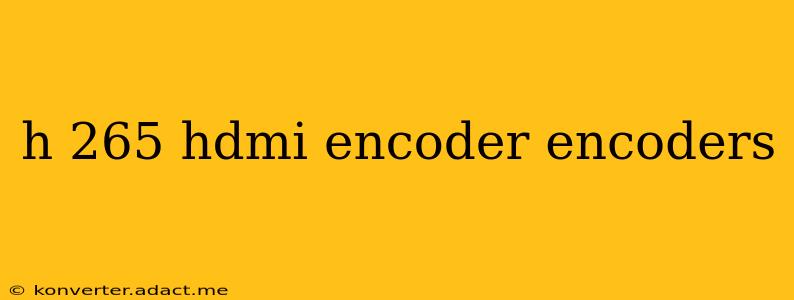The world of video encoding is constantly evolving, and H.265 (also known as HEVC – High Efficiency Video Coding) has emerged as a leading standard for its superior compression capabilities. This translates to higher quality video at lower bitrates, making it ideal for a variety of applications. This guide delves into H.265 HDMI encoders, exploring their features, benefits, and applications. We'll cover everything from choosing the right encoder to troubleshooting common issues.
What is an H.265 HDMI Encoder?
An H.265 HDMI encoder is a device that takes an HDMI video signal as input and converts it into an H.265 compressed video stream. This compressed stream can then be transmitted over a network, stored on a hard drive, or streamed live. Essentially, it takes high-quality, high-bandwidth video and makes it manageable for various distribution methods. The encoder utilizes the H.265 codec, resulting in significantly smaller file sizes compared to older codecs like H.264, while maintaining or even improving visual quality.
Benefits of Using H.265 HDMI Encoders
The advantages of choosing an H.265 HDMI encoder are substantial:
- Superior Compression: H.265 achieves significantly higher compression ratios than H.264, reducing storage space requirements and bandwidth consumption. This is crucial for applications involving large volumes of video data.
- Improved Video Quality: Despite the higher compression, H.265 generally delivers better video quality at the same bitrate compared to H.264. This results in sharper images and more detailed visuals.
- Cost Savings: Reduced bandwidth and storage needs translate to lower operational costs, especially beneficial for businesses dealing with large-scale video deployments.
- Enhanced Efficiency: H.265's efficiency allows for smoother streaming and playback, even over less-than-ideal network conditions.
What are the Different Types of H.265 HDMI Encoders?
H.265 HDMI encoders come in various forms, each tailored to specific needs and applications:
- Standalone Encoders: These are self-contained units that typically include all necessary components for encoding and outputting the compressed video stream. They are often more versatile and can handle a wider range of input and output options.
- Software-Based Encoders: These encoders utilize software running on a computer or server. While flexible, they generally require more powerful hardware to manage the encoding process efficiently.
- Embedded Encoders: These encoders are integrated into other devices, such as cameras or video streaming appliances. They offer a compact and convenient solution, especially when integrated seamlessly into a larger system.
What are the Key Features to Consider When Choosing an H.265 HDMI Encoder?
Selecting the right encoder requires careful consideration of several key features:
- Resolution and Frame Rate: Ensure the encoder supports the desired resolution (e.g., 1080p, 4K) and frame rate (e.g., 30fps, 60fps) for your application.
- Bitrate Control: The ability to adjust the bitrate allows for optimization of video quality and file size. Higher bitrates result in better quality but larger files.
- Input and Output Options: Consider the available input and output interfaces (HDMI, network, USB, etc.) to ensure compatibility with your existing infrastructure.
- Network Protocols: Determine the supported network protocols (RTMP, RTSP, HLS, etc.) for seamless integration with your streaming or storage solution.
- Power Consumption: For long-term deployments, power consumption is a critical factor to consider.
How Much Does an H.265 HDMI Encoder Cost?
The cost of an H.265 HDMI encoder varies significantly depending on its features and capabilities. Simple, standalone encoders can be relatively inexpensive, while more advanced models with higher resolutions, more features, and robust network capabilities can be considerably more costly. Researching and comparing different models from various vendors is essential to finding the best price-performance ratio for your specific needs.
Where Can I Buy an H.265 HDMI Encoder?
H.265 HDMI encoders are available from a variety of online retailers and electronics suppliers. Many manufacturers also sell their products directly. Thoroughly researching different vendors and comparing prices before making a purchase is crucial to ensure you’re getting the best deal.
How to Set Up and Configure an H.265 HDMI Encoder?
The setup and configuration process varies depending on the specific encoder model. However, most encoders involve connecting the HDMI source, configuring network settings, and specifying encoding parameters like resolution, frame rate, and bitrate. Detailed instructions are typically provided in the encoder's user manual. If you encounter difficulties, referring to the manufacturer's website for support resources, including troubleshooting guides and FAQs, is often helpful.
What are Common Problems with H.265 HDMI Encoders?
Some common issues with H.265 HDMI encoders include network connectivity problems, incorrect configuration settings, and hardware malfunctions. Troubleshooting usually involves checking cable connections, verifying network settings, and reviewing the encoder's logs for error messages. If the issue persists, contacting the manufacturer's support team can be necessary.
This comprehensive guide provides a strong foundation for understanding and utilizing H.265 HDMI encoders. By considering the key features, benefits, and potential challenges, you can make an informed decision to select the best encoder for your specific video encoding needs. Remember to always consult the manufacturer's documentation for detailed instructions and troubleshooting information specific to your chosen model.
